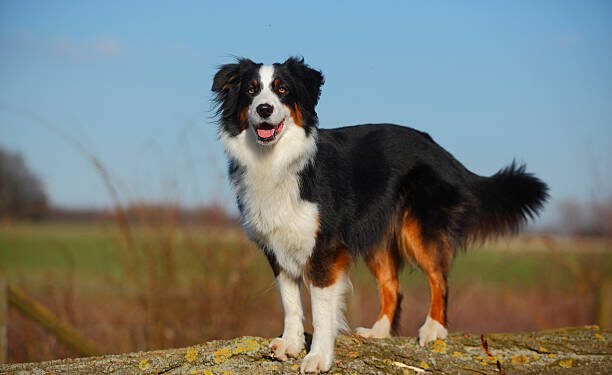Introduction:
The Australian Shepherd, often affectionately known as the “Aussie,” is a remarkable and highly versatile dog breed that has captured the hearts of dog enthusiasts worldwide. Known for their intelligence, agility, and striking appearance, Australian Shepherds are a breed like no other. In this comprehensive guide, we will delve into the world of Australian Shepherds, providing you with a complete overview of their unique characteristics and care requirements.
But first, did you know that the Australian Shepherd has no actual connection to Australia? Despite the name, these dogs are believed to have originated in the Western United States, where they were bred to work as herding dogs on ranches. Now, let’s explore the fascinating world of Australian Shepherds.
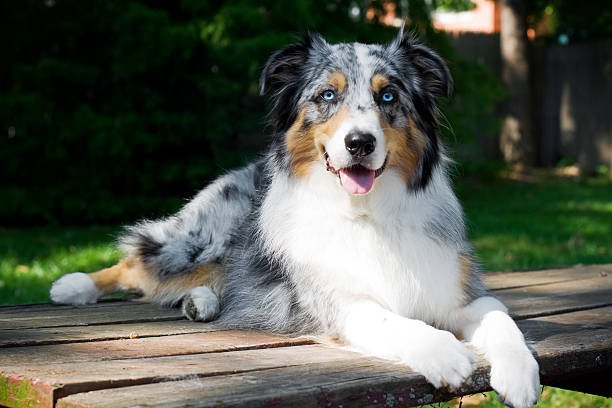
Australian Shepherd Dog Breed Information
To better understand this remarkable breed, let’s break down the essential characteristics of Australian Shepherds:
| Field | Information |
|---|---|
| Height | Typically ranges from 18 to 23 inches at the shoulder. |
| Weight | Generally between 40 to 65 pounds. |
| Life Span | About 12 to 15 years on average. |
| Good with | Known for being excellent companions for active families and individuals. |
| Temperament | Intelligent, loyal, energetic, and highly trainable. |
| Intelligence | Considered one of the most intelligent dog breeds. |
| Shedding Amount | Moderate shedding throughout the year, with heavier shedding during seasonal changes. |
| Grooming | Regular brushing and occasional baths are necessary to maintain their beautiful double coat. |
| Exercise Needs | High exercise requirements; they thrive on physical and mental stimulation. |
| Energy Level | Extremely high energy levels, making them ideal for various dog sports and activities. |
| Barking Level | Prone to barking, especially when not given enough mental and physical stimulation. |
| Drool Amount | Typically, Australian Shepherds are not known to be heavy droolers. |
| Coat Length/Texture | Double coat with a dense, weather-resistant undercoat and a longer outer coat. |
| Colors | Australian Shepherds come in various coat colors, including black, red, blue merle, and red merle. |
| Patterns | They can have a variety of coat patterns, including solid, bi-color, and tri-color variations. |
Now that we have a basic understanding of the Australian Shepherd’s physical characteristics and personality traits, let’s dive deeper into their history, temperament, training, and care requirements in subsequent sections. Whether you’re a proud Aussie owner or considering bringing one into your home, this guide will equip you with valuable insights to ensure a harmonious and fulfilling relationship with your Australian Shepherd.
Table of Contents
Breed History and Origin
Exploring Their Roots:
The history of the Australian Shepherd is a captivating tale that takes us back to the Western United States, where these intelligent and hardworking dogs were initially developed. Despite their name, they have no direct ties to Australia but were bred in America for a specific purpose.

The Ranching Connection
The Australian Shepherd’s journey begins in the 19th century when ranchers and sheepherders in the American West sought to improve their herding dog’s abilities. They needed a breed that could handle the rugged terrain and the unique challenges of herding livestock in the region.
To achieve this, they selectively bred dogs with excellent herding instincts and stamina. While the precise breeds that contributed to the Australian Shepherd’s development are not documented, it’s believed that Collies, Border Collies, and Basque Shepherds played significant roles. These dogs brought their own unique characteristics to the mix, including intelligence, agility, and a strong work ethic.
Notable Traits:
The Australian Shepherd, as a result of this careful breeding, exhibits several distinctive traits that have made them stand out throughout history:
- Intelligence: Australian Shepherds are renowned for their exceptional intelligence. This trait was essential for herding dogs, as they needed to make quick decisions while working independently.
- Agility: Their agility is another standout feature. These dogs are incredibly nimble and have the ability to navigate rough terrain with ease, a crucial skill when herding livestock on uneven ground.
- Herding Instinct: The Australian Shepherd’s innate herding instinct is deeply ingrained. They possess an uncanny ability to anticipate the movements of livestock and effectively control them.
- Versatility: Perhaps one of the most remarkable traits of the Australian Shepherd is their versatility. They excelled not only in herding but also in various dog sports and activities, thanks to their quick learning and adaptability.
- Loyal Companionship: Beyond their work on the ranch, Australian Shepherds formed strong bonds with their human counterparts. Their loyalty and devotion made them cherished companions to ranchers and their families.
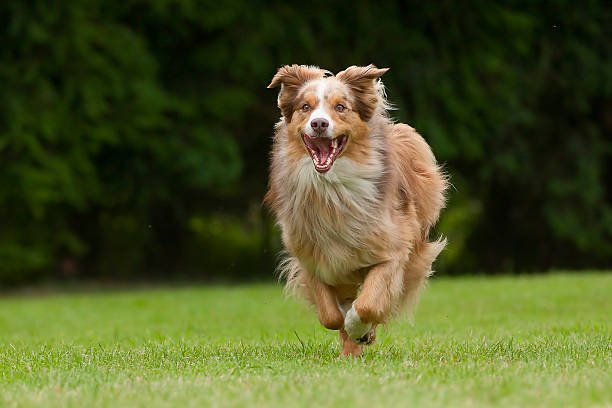
Relevance of Origin:
Understanding the breed’s origin is essential to grasp why Australian Shepherds possess the characteristics they do today. Their history as working dogs on ranches shaped their intelligence, agility, and strong work ethic. These qualities remain integral to the breed’s identity, making them excellent partners for those who lead active lifestyles.
While the Australian Shepherd’s primary role has shifted from herding livestock to being beloved family pets and competitors in dog sports, their history still influences their behavior and temperament. Even as loyal companions, they retain their herding instincts, making them vigilant and protective.
In summary, the Australian Shepherd’s fascinating history and origin provide valuable insights into their unique qualities. From their ranching roots to their adaptability and intelligence, these dogs have a rich heritage that continues to shape their role in our lives today.
Understanding the Australian Shepherd Breed’s Traits
Physical Characteristics:
When you think of Australian Shepherds, their striking physical attributes immediately come to mind. These dogs are known for their captivating appearance and unique features.
Size and Build
- Height: Australian Shepherds typically stand between 18 to 23 inches at the shoulder. Males tend to be slightly taller than females.
- Weight: Their weight ranges from 40 to 65 pounds, with males being slightly heavier than females.
- Build: These dogs have a well-balanced and muscular build, reflecting their agility and athleticism.
Coat Type and Color
- Coat Type: Australian Shepherds have a double coat. The outer coat is moderately long, straight to wavy, and weather-resistant. Beneath the outer coat lies a soft, dense undercoat.
- Colors: The breed showcases a wide variety of coat colors, including black, red, blue merle, and red merle. These colors can be in combination with white markings and tan points.
Distinguishing Features
- Eyes: One of the most distinctive features of the Australian Shepherd is their eyes. They often have striking, almond-shaped eyes that come in various shades of blue, brown, or even one of each, known as “split eyes.”
- Tail: Their tails are often naturally bobbed or docked. Some Australian Shepherds have full-length tails, but a bobbed tail is a common feature.
- Ears: The breed’s ears are triangular and set high on their head, giving them an alert and expressive look.

Temperament Overview:
The Australian Shepherd’s temperament is as captivating as their appearance. They possess a combination of qualities that make them wonderful companions but also require thoughtful consideration.
Intelligence and Trainability
- Intelligence: Australian Shepherds are exceptionally intelligent dogs. They are quick learners and thrive when given mental challenges.
- Trainability: Due to their intelligence and strong work ethic, they are highly trainable. They excel in obedience training, agility, and various dog sports.
Suitability as Family Pets
- Family-Friendly: Australian Shepherds can make fantastic family pets. They are known for their loyalty and love for their human family members.
- Children: When properly socialized and raised with children, Australian Shepherds can be great with kids. They are often protective of their little human friends.
- Compatibility with Other Pets: While they have strong herding instincts, Australian Shepherds can coexist with other pets, especially if introduced to them at a young age.

Environmental Needs
- Space: These active dogs thrive in environments where they have plenty of space to run and play. They are not well-suited for apartment living and will do best in a home with a yard.
- Exercise Requirements: Australian Shepherds have high energy levels and need daily exercise. This can include brisk walks, runs, and engaging playtime.
- Climate: They can adapt to various climates but should not be exposed to extreme heat due to their thick double coat.
Training and Socialization:
Training and socialization are crucial aspects of caring for an Australian Shepherd.
- Training: Consistent and positive reinforcement-based training methods work best with this breed. They thrive on mental stimulation and enjoy learning new commands and tricks.
- Socialization: Early and ongoing socialization is essential to ensure that Australian Shepherds are well-adjusted and confident around other dogs and people. Proper socialization can help minimize any potential behavioral issues.
In conclusion, Australian Shepherds are a breed with remarkable physical characteristics, a loyal temperament, and specific environmental and training needs. While they require an active lifestyle and consistent training, their intelligence and loving nature make them an excellent choice for individuals and families who can meet their requirements and appreciate their unique qualities.
Health Considerations and Care
Taking care of your Australian Shepherd’s health and well-being is paramount to ensuring they live a long, happy life. In this section, we’ll delve into various aspects of health care for this breed.
Common Health Issues:
While Australian Shepherds are generally healthy dogs, like all breeds, they can be prone to specific health concerns. Being aware of these issues and regular veterinary check-ups can help catch and address problems early.
Common Health Concerns:
- Hip Dysplasia: This genetic condition can affect the hip joints, causing discomfort and reduced mobility. Regular hip evaluations are crucial.
- Elbow Dysplasia: Similar to hip dysplasia, this condition affects the elbow joints and can lead to lameness.
- Eye Issues: Australian Shepherds can be susceptible to various eye problems, including cataracts and progressive retinal atrophy (PRA). Regular eye exams are essential.
- Epilepsy: Some Australian Shepherds may develop epilepsy, a neurological disorder that causes seizures.
- Autoimmune Disorders: Certain autoimmune disorders, such as autoimmune thyroiditis, can affect this breed.
- Allergies: Skin allergies are not uncommon in Australian Shepherds, so monitoring for signs of itching or irritation is important.
- Cancer: Like many breeds, Australian Shepherds can be prone to cancer. Regular check-ups and cancer screenings are advisable.
Lifespan and Longevity:
The average lifespan of an Australian Shepherd is around 12 to 15 years. To promote a longer and healthier life for your dog, consider the following tips:
Tips for Promoting Longevity:
- Regular Vet Visits: Schedule regular check-ups with your veterinarian to catch and address health issues early.
- Balanced Diet: Provide a well-balanced diet tailored to your dog’s age and activity level. Consult with your vet for dietary recommendations.
- Exercise and Mental Stimulation: Ensure your Australian Shepherd gets ample exercise and mental stimulation to prevent boredom and maintain their physical and mental health.
- Weight Management: Maintain a healthy weight for your dog to reduce the risk of joint problems and obesity-related issues.
- Dental Care: Implement a dental care routine, including brushing your dog’s teeth and providing dental chews, to prevent dental issues.
- Parasite Control: Keep up with parasite control measures, including flea, tick, and heartworm prevention.
- Spaying/Neutering: Discuss the timing of spaying or neutering with your vet, as this can impact your dog’s health.
Diet and Nutrition:
Proper nutrition is essential for the well-being of your Australian Shepherd. Here’s what you need to know about their dietary needs:
Dietary Guidelines:
- High-Quality Dog Food: Choose a high-quality dog food that meets the nutritional needs of your Australian Shepherd. Look for options with real meat as the primary ingredient.
- Portion Control: Avoid overfeeding, as Australian Shepherds can gain weight quickly. Follow the recommended portion sizes on the dog food packaging.
- Feeding Schedule: Establish a consistent feeding schedule to help with digestion. Most adult dogs are fed twice a day.
- Avoid Table Scraps: Resist the temptation to feed your dog from the table. Human food can lead to digestive issues and obesity.
- Fresh Water: Always provide fresh, clean water for your dog.
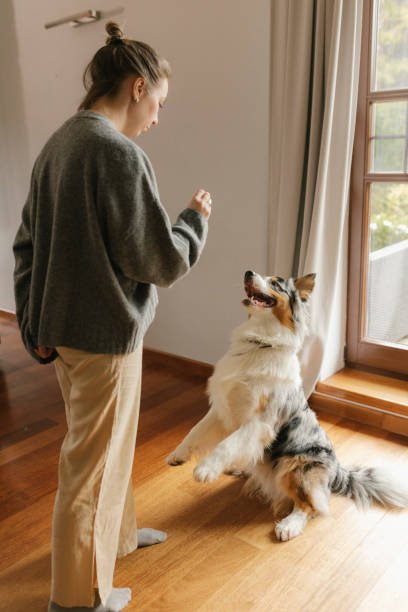
Exercise and Activity:
Australian Shepherds are high-energy dogs that require regular exercise and mental stimulation to thrive. Here’s how to meet their exercise needs:
Exercise Recommendations:
- Daily Exercise: Aim for at least 60-90 minutes of physical activity each day. This can include walks, runs, fetch, and interactive play.
- Mental Stimulation: These intelligent dogs benefit from puzzle toys, obedience training, and agility exercises to keep their minds sharp.
- Socialization: Regularly expose your Australian Shepherd to different people, animals, and environments to promote socialization and prevent behavioral issues.
Grooming and Maintenance:
Maintaining your Australian Shepherd’s coat and overall hygiene is essential to their well-being. Here are some grooming practices to follow:
Grooming Tips:
- Brushing: Brush your dog’s coat at least once a week to prevent matting and reduce shedding. During shedding seasons, more frequent brushing may be required.
- Bathing: Bathe your Australian Shepherd as needed, typically every 6-8 weeks or when they get dirty. Use a dog-specific shampoo.
- Ear and Eye Cleaning: Regularly inspect and clean your dog’s ears and eyes to prevent infections and irritation.
- Dental Care: Brush your dog’s teeth regularly to prevent dental issues. Dental chews can also help maintain oral health.
- Nail Trimming: Keep your dog’s nails trimmed to a comfortable length to prevent overgrowth and potential issues.
By following these health and care guidelines, you can ensure that your Australian Shepherd lives a long, happy, and healthy life. Regular veterinary check-ups, a balanced diet, ample exercise, and proper grooming are essential for their overall well-being.
Choosing and Adopting an Australian Shepherd Dog Breed
Adopting an Australian Shepherd can be a rewarding experience, but it also comes with responsibilities and considerations. In this section, we’ll explore the process of choosing and adopting an Australian Shepherd, highlighting the benefits of adoption, research and preparation, the adoption process, and ethical considerations.

Reasons for Adoption:
Before delving into the adoption process, it’s essential to understand the benefits of adopting an Australian Shepherd breed, particularly from rescue organizations or shelters.
Benefits of Adoption:
- Saving Lives: By adopting a dog from a rescue or shelter, you are giving a dog a second chance at life. Many Australian Shepherds end up in shelters due to various reasons, and your adoption can save a life.
- Temperament Assessment: Rescue organizations often assess the temperament and behavior of dogs before adoption. This can help match you with a dog that suits your lifestyle and preferences.
- Health Screening: Reputable rescue organizations typically provide veterinary care and health screening for their dogs. This means you’ll have information about the dog’s health before adopting.
- Supporting Rescue Efforts: Your adoption fee often goes towards supporting the rescue organization’s efforts to care for and re-home more dogs in need.
- Fulfilling Companionship: Australian Shepherds are known for their loyalty and companionship. Adopting one can bring joy and fulfillment to your life while providing a loving home to a dog in need.
Research and Preparation:
Before adopting an Australian Shepherd, it’s crucial to do your research and adequately prepare for the responsibilities of dog ownership.
Tips for Research and Preparation:
- Breed-Specific Needs: Understand the specific needs of Australian Shepherds, including their exercise requirements, grooming needs, and temperament traits.
- Financial Responsibilities: Be prepared for the financial responsibilities of dog ownership, including veterinary care, grooming, food, and supplies.
- Training Knowledge: Educate yourself about dog training and behavior to ensure a smooth transition for your new companion.
- Lifestyle Evaluation: Assess your lifestyle and living situation to determine if it’s conducive to owning an active breed like the Australian Shepherd.
Adoption Process:
The adoption process for an Australian Shepherd typically involves several steps, whether you are adopting from a rescue organization or a shelter.
Steps in the Adoption Process:
- Research and Contact: Begin by researching reputable rescue organizations or shelters that specialize in Australian Shepherds. Contact them to express your interest in adopting.
- Application: Most organizations require you to fill out an adoption application. This application may include questions about your living situation, experience with dogs, and preferences for the type of Australian Shepherd you are looking for.
- Home Visit: Some organizations may conduct a home visit to ensure that your living environment is suitable for an Australian Shepherd. This is to ensure the safety and well-being of the dog.
- Meet-and-Greet: Once your application is approved, you’ll have the opportunity to meet potential adoptable dogs. Spend time interacting with them to assess their compatibility with your family.
- Adoption Fee: Be prepared to pay an adoption fee, which often covers the cost of vaccinations, spaying/neutering, and other initial veterinary care.
- Paperwork: Complete any necessary paperwork, including adoption agreements and medical records.
- Transition Period: Allow for an adjustment period as your new Australian Shepherd settles into their new home. Be patient and provide plenty of love and support during this time.
Breeding and Ethical Considerations:
While adoption is an excellent option, it’s also important to understand the ethical considerations of responsible breeding.
Responsible Breeding:
- Health Screening: Responsible breeders prioritize the health of their dogs. They conduct health screenings for genetic conditions that may affect the breed.
- Genetic Diversity: Ethical breeders aim to maintain genetic diversity within the breed, reducing the risk of hereditary health issues.
- Socialization and Care: Puppies from responsible breeders are typically well-socialized and receive proper care from birth.
- Lifetime Support: Reputable breeders offer lifetime support and guidance to puppy buyers.
- No Puppy Mills: Avoid purchasing puppies from puppy mills or backyard breeders, as these sources often prioritize profit over the well-being of the dogs.
In conclusion, adopting an Australian Shepherd can be a fulfilling experience, offering numerous benefits to both you and the dog. It’s essential to research and prepare adequately, follow the adoption process diligently, and consider the ethical aspects of responsible breeding. Whether you choose adoption or responsible breeding, providing a loving and caring home for an Australian Shepherd is a wonderful way to welcome this intelligent and loyal breed into your life.
Popularity and Recognition
Understanding the popularity and recognition of the Australian Shepherd breed is essential for anyone considering bringing one of these intelligent and energetic dogs into their home. In this section, we’ll explore the current popularity of Australian Shepherds, their recognition by kennel clubs and breed organizations, and notable breed varieties.
Current Popularity:
The popularity of dog breeds can vary over time and across regions. As of my last knowledge update in September 2021, the Australian Shepherd was gaining popularity, particularly in the United States. Their intelligence, agility, and friendly disposition make them attractive to dog enthusiasts and families alike.
Trends in Ownership:
- Family-Friendly: Australian Shepherds are increasingly becoming a preferred choice for families due to their loyalty, affection, and suitability for active households.
- Working Dogs: They remain highly regarded as working dogs on farms and ranches, where their herding skills are put to good use.
- Dog Sports: The breed’s agility and trainability have made them favorites in various dog sports, such as agility trials and obedience competitions.
- City Living: Surprisingly, Australian Shepherds are also adapting well to urban living, provided they receive ample exercise and mental stimulation.
Please note that the popularity of dog breeds can change, so it’s essential to check the most recent data and trends in your region if you are considering adopting an Australian Shepherd.
Breed Recognition:
Recognition by kennel clubs and breed organizations provides credibility and ensures that breed standards are maintained.
Recognized by Kennel Clubs:
- American Kennel Club (AKC): The Australian Shepherd is recognized by the AKC as part of the Herding Group. They were officially recognized by the AKC in 1993.
- United Kennel Club (UKC): The UKC also recognizes the Australian Shepherd as a herding breed, and they are part of the Herding Dog Group.
- The Fédération Cynologique Internationale (FCI): The FCI, the international canine organization, recognizes the Australian Shepherd under various names, including the “Aussie.”
- Other Kennel Clubs: In addition to these major kennel clubs, the breed is recognized by various national and international kennel clubs and organizations.
Notable Breed Varieties:
The Australian Shepherd breed itself doesn’t have distinct varieties like some other breeds (e.g., American vs. English Bulldogs). However, there are variations in coat colors and patterns within the breed.
Coat Colors and Patterns:
- Black Tri: This is one of the most common color combinations for Australian Shepherds. It consists of a black coat with white markings and tan points.
- Red Tri: Similar to the black tri, the red tri has a red coat with white markings and tan points.
- Blue Merle: Blue merle Australian Shepherds have a marbled blue-gray coat with black patches and white markings. Their eyes can be blue or have a marbled appearance.
- Red Merle: Red merle Australian Shepherds have a marbled red coat with red patches and white markings. Like blue merles, their eyes can be blue or marbled.
- Solid Colors: While less common, some Australian Shepherds come in solid colors, including black, red, and blue.
- Bi-color and Tri-color: Variations of these colors can result in bi-color or tri-color coats, where combinations of black, red, and blue are present.
It’s important to note that while coat color and patterns vary, the breed’s temperament and characteristics remain consistent. Whether you choose a black tri, red merle, or another variety, you can expect the same intelligence, loyalty, and energy from your Australian Shepherd.
In conclusion, the Australian Shepherd’s popularity has been on the rise, thanks to their versatility, intelligence, and loving nature. They are recognized by major kennel clubs and have variations in coat colors and patterns, providing options for those looking to adopt a dog that matches their preferences. As with any breed, responsible ownership and thorough research are essential when considering an Australian Shepherd as a companion.
Exercise and Activity Recommendations
Australian Shepherds are renowned for their high energy levels and need for regular exercise and mental stimulation. To keep your Australian Shepherd happy and healthy, it’s crucial to provide them with ample opportunities for physical activity and mental engagement. In this section, we’ll provide a detailed exercise plan, including various types of exercise, duration, and frequency, along with breed-specific exercise needs.
Exercise Plan for Australian Shepherds:
Australian Shepherds thrive on physical activity, and it’s essential to incorporate a well-rounded exercise routine into their daily lives. Here’s a comprehensive exercise plan to keep your Aussie in top shape:
Types of Exercise:
- Daily Walks: Take your Australian Shepherd for brisk daily walks. These walks should last at least 30 minutes to an hour. Walking not only provides physical exercise but also mental stimulation as they explore their surroundings.
- Playtime: Engage in interactive play sessions with toys like balls, frisbees, and tug-of-war ropes. Playtime should occur several times a day, with each session lasting 15-30 minutes.
- Agility Training: Australian Shepherds excel in agility training. Set up an agility course in your backyard or find a local agility club where you can participate in classes. Agility training challenges their minds and keeps them physically fit.

- Fetch: Aussies love to play fetch. Throw a ball or frisbee, and let them chase and retrieve it. This activity provides both physical exercise and mental stimulation.
- Swimming: If you have access to a pool or a safe swimming area, Australian Shepherds often enjoy swimming. It’s an excellent way to provide low-impact exercise, especially during hot weather.
- Hiking: Take your Australian Shepherd on hiking adventures. They thrive in outdoor environments and will happily accompany you on long hikes through nature.
Duration and Frequency:
- Daily Exercise: Aim for a minimum of 60-90 minutes of exercise each day. This can include a combination of walking, playtime, and training sessions.
- Variety: Vary the types of exercise to prevent boredom and engage different muscle groups. For example, one day could focus on agility training, while the next might involve a long hike.
- Consistency: Maintain a consistent exercise schedule. Australian Shepherds thrive on routine and will come to expect and appreciate regular exercise.
Breed-Specific Exercise Needs:
Australian Shepherds have some breed-specific exercise needs due to their herding background and high energy levels:
- Herding Instinct: These dogs may exhibit herding behaviors, even in a household setting. Engage their herding instincts by providing them with tasks like fetch or agility training.
- Mental Stimulation: In addition to physical exercise, Australian Shepherds require mental stimulation. Puzzle toys, obedience training, and interactive games can help challenge their minds.
- Outdoor Time: They thrive in outdoor environments, so whenever possible, provide opportunities for them to run and explore in safe, enclosed spaces.

Nutrition and Feeding Guidelines
Proper nutrition is vital for the health and well-being of your Australian Shepherd. To ensure they receive the right nutrients, consider the following dietary recommendations:
Dietary Recommendations:
- High-Quality Dog Food: Choose a high-quality commercial dog food that is appropriate for your Australian Shepherd’s age, size, and activity level. Look for options that list real meat as the primary ingredient.
- Portion Control: Follow the feeding guidelines on the dog food packaging to determine the appropriate portion size for your dog. Be mindful of their weight and adjust portions accordingly.
- Age-Appropriate Diet: Puppies, adult dogs, and seniors have different nutritional needs. Ensure you’re feeding them the appropriate formula for their life stage.
- Protein and Fat: Australian Shepherds benefit from a diet with moderate to high protein and fat content to support their active lifestyle.
- Avoid Table Scraps: Refrain from feeding your dog human food from the table. Many human foods can be harmful to dogs and lead to digestive issues.
- Dietary Restrictions: Some Australian Shepherds may have food allergies or sensitivities. If your dog displays signs of allergies (itching, digestive upset), consult your veterinarian for guidance on an appropriate diet.
Feeding Schedule:
- Frequency: Most adult Australian Shepherds do well with two meals a day. Puppies may require more frequent feeding.
- Scheduled Meals: Establish a consistent feeding schedule to regulate your dog’s digestion. Avoid free-feeding, where food is constantly available.
- Water: Always provide fresh, clean water for your dog. Proper hydration is essential, especially after exercise.
In summary, Australian Shepherds are active and intelligent dogs that require a well-structured exercise routine to keep them physically and mentally stimulated. Providing them with a balanced diet tailored to their specific needs is equally crucial for their overall health and well-being. By following these exercise and nutrition guidelines, you can ensure that your Australian Shepherd leads a happy and healthy life.
Socialization and Training Tips
Socializing and training your Australian Shepherd are critical aspects of ensuring they become well-behaved and happy companions. Australian Shepherds are known for their intelligence and herding instincts, which can be harnessed with the right training. In this section, we’ll provide breed-specific training tips and advice on socializing your Australian Shepherd with other dogs and people.

Breed-Specific Training Tips:
Training an Australian Shepherd can be a rewarding experience, given their high intelligence and eagerness to please. However, their strong herding instincts and boundless energy require specific training strategies:
1. Start Early:
- Puppy Training: Begin training your Australian Shepherd as early as possible, ideally when they are still puppies. Early training helps prevent bad habits from forming.
2. Positive Reinforcement:
- Reward-Based Training: Use positive reinforcement techniques, such as treats and praise, to reward desired behaviors. Aussies respond well to positive feedback.
- Consistency: Be consistent in your commands and rewards. This helps your dog understand what is expected of them.
3. Mental Stimulation:
- Mental Challenges: Australian Shepherds need mental stimulation as much as physical exercise. Incorporate puzzle toys, obedience training, and trick training into their routine.
4. Herding Instinct:
- Channel Herding Instinct: Understand that Australian Shepherds have strong herding instincts. Train them to use these instincts appropriately, such as in agility courses or by providing them with tasks.
- Control Nipping: Some Aussies may display nipping behaviors due to their herding instincts. Teach them to control this behavior during playtime and socialization.
5. Socialization:
- Early Exposure: Begin socializing your Australian Shepherd early by exposing them to different people, dogs, and environments.
- Positive Social Interactions: Encourage positive interactions with other dogs and reward good behavior during socialization.
- Obedience Classes: Consider enrolling your Aussie in obedience classes to improve their social skills and responsiveness to commands.
Common Behavioral Traits:
Understanding the behavioral traits of Australian Shepherds can help you manage and address any challenges effectively. Here, we’ll discuss both positive and challenging behavioral traits associated with the breed:
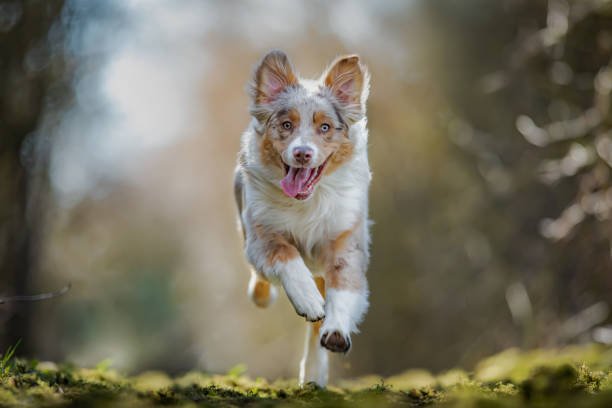
Positive Traits:
- Loyal and Affectionate: Australian Shepherds are known for their loyalty and deep affection for their families. They form strong bonds and are highly protective.
- Intelligent and Trainable: Their intelligence makes them highly trainable. They excel in obedience training, agility, and even dog sports like frisbee.
- Energetic and Playful: Aussies are playful and full of energy, making them great companions for active individuals and families.
- Alert and Watchful: They are excellent watchdogs and will alert you to any potential intruders or disturbances.
Challenging Traits:
- Herding Instinct: While their herding instinct can be useful, it can also lead to behaviors like chasing and nipping at children or other pets. Early training is crucial to manage this.
- Separation Anxiety: Australian Shepherds can develop separation anxiety if left alone for long periods. They thrive on human interaction.
- Barking Tendency: They can be vocal and may bark to communicate their needs or when bored.
- High Exercise Needs: Their boundless energy requires daily exercise, and they can become destructive if not adequately exercised and mentally stimulated.
Managing Behavioral Issues:
To manage and address behavioral issues with your Australian Shepherd, consider the following:
- Consistent Training: Consistency in training and positive reinforcement techniques can help address challenging behaviors.
- Mental Stimulation: Providing mental stimulation through puzzle toys and training can alleviate boredom-related issues.
- Socialization: Continued socialization can help reduce anxiety and improve their interactions with other dogs and people.
- Exercise Routine: Stick to a consistent exercise routine to channel their energy in a positive way.
- Professional Help: If behavioral issues persist or become severe, consider consulting a professional dog trainer or behaviorist.
In conclusion, training and socializing your Australian Shepherd are essential for their well-being and happiness. Their intelligence and herding instincts make them trainable, but it’s crucial to provide consistent and positive training methods. Understanding their behavioral traits, both positive and challenging, will help you effectively manage and address any issues that may arise, ensuring that your Australian Shepherd is a well-adjusted and delightful companion.
Personal Stories and Testimonials
When it comes to understanding the Australian Shepherd breed and what it’s like to have one as a pet, there’s nothing quite like hearing from real-life owners who have experienced the joys, challenges, and unique personalities of these dogs. In this section, we’ll include personal stories and testimonials from Australian Shepherd owners, shedding light on the cost of owning this breed, expenses related to grooming and care, as well as the pros and cons of having an Australian Shepherd as a pet.
Cost of Owning an Australian Shepherd
Owning any dog comes with financial responsibilities, including food, veterinary care, grooming, and other essentials. Australian Shepherds are no exception. Here are insights into the costs associated with having an Australian Shepherd:

1. Initial Purchase or Adoption:
- Breeder Purchase: If you buy from a reputable breeder, the costof an Australian Shepherd puppy can range from $600 to $1,800 or more, depending on the breeder’s reputation, bloodline, and location.
- Adoption Fees: Adopting from a rescue organization typically involves adoption fees that can range from $50 to $500. This fee often covers initial vaccinations, spaying/neutering, and microchipping.
2. Food and Supplies:
- Monthly Food Costs: Expect to spend approximately $50 to $100 per month on high-quality dog food for an Australian Shepherd. Puppies may require more frequent feeding.
- Toys and Accessories: Initial purchases of toys, bedding, leashes, and collars can add up to around $100 to $200.
3. Veterinary Care:
- Routine Vet Visits: Annual check-ups and vaccinations can cost between $100 to $300. This cost may vary based on location and the specific services provided.
- Emergency Care: Be prepared for potential emergency vet visits, which can range from a few hundred to several thousand dollars, depending on the nature of the emergency.
4. Grooming and Maintenance:
- Grooming Costs: Australian Shepherds have a double coat and require regular grooming. Professional grooming sessions can cost between $50 to $100 per session, depending on your location and the groomer’s expertise.
- At-Home Grooming: Some owners choose to groom their dogs at home, which requires an investment in grooming tools and supplies.
5. Training and Socialization:
- Training Classes: Enrolling your Australian Shepherd in obedience or agility classes may cost between $100 to $300 for a multi-week course.
6. Miscellaneous Expenses:
- Insurance: Some owners opt for pet insurance, which can cost around $30 to $60 per month.
- Travel Costs: If you plan to travel with your dog, factor in expenses for pet-friendly accommodations and transportation.
Pros and Cons of Having an Australian Shepherd as a Pet
To provide a well-rounded perspective, let’s hear from Australian Shepherd owners about the pros and cons of having this breed as a pet.

Pros:
1. Loyal Companionship
Testimonial: “My Australian Shepherd, Max, is incredibly loyal. He’s my constant companion, always by my side, and I couldn’t ask for a more faithful friend.” – Sarah
2. Intelligent and Trainable
Testimonial: “Training my Aussie, Bella, has been a breeze. She’s incredibly intelligent and always eager to learn new tricks. It’s a joy to work with her.” – Mark
3. Active Lifestyle Partner
Testimonial: “If you love an active lifestyle, an Aussie is the perfect partner. Hiking, running, and playing fetch are daily activities for us, and I couldn’t be happier.” – Emily
4. Versatility
Testimonial: “One of the best things about owning an Australian Shepherd is their versatility. They excel in so many activities, from herding to agility to therapy dog work. It’s amazing to see their adaptability.” – James
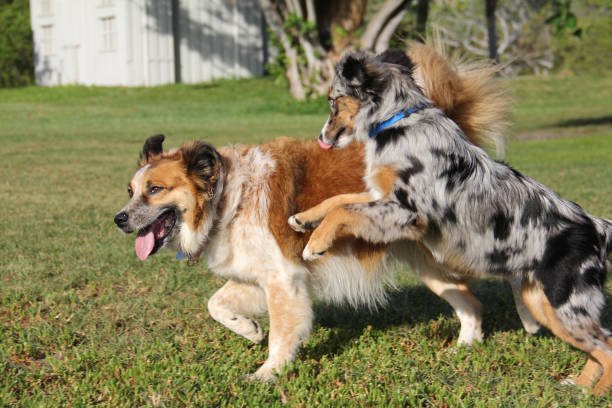
Cons:
1. High Exercise Needs
Testimonial: “Owning an Aussie means committing to daily exercise, rain or shine. Sometimes it can be exhausting to meet their energy levels.” – Lisa
2. Separation Anxiety
Testimonial: “My Aussie, Luna, struggles with separation anxiety. If I’m away for too long, she becomes anxious and starts barking. It can be challenging to manage.” – Robert
3. Herding Instincts
Testimonial: “The herding instincts can be both a blessing and a challenge. My Australian Shepherd, Rocky, tends to ‘herd’ my kids, which can be cute but also a bit overbearing at times.” – Maria
4. Shedding
Testimonial: “Be prepared for lots of shedding. My Aussie’s double coat means there’s hair everywhere, no matter how much I groom him.” – John
In conclusion, owning an Australian Shepherd can be a rewarding experience, but it’s essential to be aware of the financial commitment and the breed’s unique characteristics. Hearing from real owners and their personal stories provides valuable insights into what it’s like to have an Australian Shepherd as a pet. Whether you’re drawn to their loyalty, intelligence, and versatility or mindful of their exercise needs and herding instincts, understanding the pros and cons will help you make an informed decision about bringing this wonderful breed into your life.
Breed-Specific Accessories and Care Products for Australian Shepherds
Providing the right accessories and care products is essential to ensure the well-being and happiness of your Australian Shepherd. These intelligent and active dogs have specific needs that can be met with the right tools and products. In this section, we will recommend specific accessories and care products tailored to the Australian Shepherd breed’s needs, including grooming tools, harnesses, toys, and more.
1. Grooming Tools:
Australian Shepherds have a thick double coat that requires regular grooming to keep it healthy and reduce shedding. Here are some grooming tools that are particularly useful for this breed:
- Slicker Brush: A slicker brush helps remove loose hair and prevents matting in the dense coat.
- Undercoat Rake: This tool is effective at getting through the undercoat to reduce shedding.
- Grooming Shears: For trimming the fur around the ears, paws, and tail, a good pair of grooming shears is essential.
- Nail Clippers: Regular nail maintenance is crucial. Opt for quality nail clippers designed for dogs.
- Deshedding Tool: A deshedding tool like the Furminator can help significantly reduce shedding.
2. Harnesses and Leashes:
Australian Shepherds are strong and agile dogs, so a well-fitted harness and leash are essential for control and comfort during walks and other activities. Consider the following options:
- No-Pull Harness: If your Aussie tends to pull on walks, a no-pull harness can provide better control without choking or discomfort.
- Reflective Harness: For evening or early morning walks, a reflective harness enhances visibility and safety.
- Long Line Leash: These leashes provide more freedom for off-leash activities while maintaining control.
3. Toys and Mental Stimulation:
Aussies are known for their intelligence and need for mental stimulation. Engaging toys can help keep them mentally sharp and prevent boredom:
- Interactive Puzzle Toys: Toys that dispense treats as your dog plays with them are excellent for mental stimulation.
- Agility Equipment: Consider agility equipment like tunnels, jumps, and weave poles for backyard fun and exercise.
- Kong Classic Dog Toy: These durable toys can be stuffed with treats or peanut butter to keep your dog engaged for hours.
4. Dog Beds and Crate Accessories:
Australian Shepherds appreciate a comfortable place to rest, especially after a day of activity. Here are some bedding options:
- Orthopedic Dog Bed: These beds provide excellent support for joints, making them ideal for older Aussies.
- Crate Pad: If you crate train your dog, a crate pad adds comfort and warmth to the crate.
5. Dog Food and Feeding Accessories:
Choosing the right dog food and feeding accessories is essential for your Aussie’s health:
- High-Quality Dog Food: Opt for a high-quality dog food tailored to your dog’s age and activity level.
- Slow Feeder Bowl: If your Australian Shepherd tends to eat too quickly, a slow feeder bowl can help prevent digestive issues.
- Water and Food Dispenser: Automatic water and food dispensers ensure your dog has access to fresh water and food throughout the day.
6. Training Aids:
Training your Australian Shepherd is crucial for their well-being. Consider these training aids:
- Clicker: Clicker training is an effective way to reinforce positive behavior.
- Training Treats: High-value treats can be excellent motivators during training sessions.
7. Health and Wellness Products:
Maintaining your Aussie’s health is a top priority. These products can help:
- Flea and Tick Prevention: Depending on your location, flea and tick prevention products may be necessary.
- Supplements: Joint supplements like glucosamine can help maintain joint health, especially in older dogs.
- Dental Chews and Toothbrushes: Dental health is vital. Dental chews and toothbrushes can help keep their teeth clean.
8. Travel Accessories:
If you plan to travel with your Australian Shepherd, these accessories can be invaluable:
- Car Harness or Seat Belt: Keep your dog safe during car rides with a harness or seat belt designed for dogs.
- Travel Crate: A collapsible travel crate provides a familiar and secure space for your Aussie while on the road.
9. Outdoor Gear:
For adventurous Aussies, outdoor gear can enhance the experience:
- Backpack: A dog backpack allows your Aussie to carry essentials on hikes.
- Water Bottle and Bowl: Stay hydrated on outdoor adventures with a portable water bottle and collapsible bowl.
10. First Aid Kit:
Having a first aid kit specific to dogs can be a lifesaver in emergencies. Ensure it includes essentials like bandages, antiseptic wipes, and tweezers for removing splinters or ticks.
Remember that every dog is unique, and their needs may vary. Consult with your veterinarian or a professional dog trainer for personalized recommendations based on your Australian Shepherd’s specific requirements. Investing in the right accessories and care products will contribute to a happy and healthy life for your beloved Aussie.
Frequently Asked Questions (FAQs) About the Australian Shepherd Breed
When it comes to the Australian Shepherd breed, potential owners and enthusiasts often have various questions. In this section, we’ve compiled a list of 10 common questions about Australian Shepherds, along with detailed answers to provide you with comprehensive insights into this remarkable breed.
1. Are Australian Shepherds Actually from Australia?
- No, despite their name, Australian Shepherds did not originate in Australia. They are believed to have been developed in the United States, likely in the Western states, during the 19th century. Their name is more likely a nod to the sheepdogs that accompanied Australian sheep imports.
2. What Is the Typical Lifespan of an Australian Shepherd?
- The average lifespan of an Australian Shepherd is 12 to 15 years. Proper care, a healthy diet, regular exercise, and routine veterinary check-ups can contribute to a longer and healthier life.
3. Do Australian Shepherds Get Along with Children?
- Yes, Australian Shepherds are generally good with children. They are known for their loyalty and protective nature, making them great family pets. However, early socialization and proper training are crucial to ensure they interact well with kids.
4. Are Australian Shepherds Prone to Specific Health Issues?
- Yes, like all breeds, Australian Shepherds can be prone to certain health issues. These may include hip dysplasia, cataracts, epilepsy, and certain genetic conditions. Regular veterinary check-ups can help detect and address these issues early.
5. How Much Exercise Do Australian Shepherds Need?
- Australian Shepherds are highly active dogs that require at least 60 to 90 minutes of exercise per day. Engaging in activities like daily walks, playtime, and agility training is essential to meet their exercise needs.
6. Do Australian Shepherds Shed a Lot?
- Yes, Australian Shepherds are moderate to heavy shedders. They have a double coat that sheds year-round, with seasonal increases in shedding. Regular grooming and brushing can help manage the shedding.
7. Are Australian Shepherds Good for First-Time Dog Owners?
- Australian Shepherds are intelligent but can be high-energy and require consistent training and exercise. While they can be suitable for first-time dog owners who are committed to their needs, they may be better suited to individuals with prior dog experience.
8. Can Australian Shepherds Live in Apartments?
- Australian Shepherds are active dogs that thrive in environments with ample space to run and play. While it’s possible for them to live in apartments, it’s essential to provide them with regular exercise and mental stimulation to prevent boredom and destructive behavior.
9. Are Australian Shepherds Good Guard Dogs?
- Australian Shepherds are alert and can be good watchdogs. They will often alert their owners to potential intruders with their barking. However, they are not typically aggressive guard dogs.
10. Do Australian Shepherds Have Color Variations?
- Yes, Australian Shepherds come in various coat colors and patterns. Common coat colors include black, blue merle, red, and red merle. These colors can appear with white markings and different patterns, making each Aussie unique.
In summary, Australian Shepherds are a fascinating breed with a unique history and a set of characteristics that make them beloved by many. Whether you’re curious about their origins, health concerns, suitability for families, or any other aspect of their care and behavior, these frequently asked questions provide valuable insights into the world of Australian Shepherds. If you’re considering bringing one into your life, it’s essential to do your research and understand their specific needs to ensure a happy and harmonious partnership.
Conclusion
In this comprehensive guide, we’ve delved into the fascinating world of Australian Shepherds, providing you with a wealth of information about this intelligent and energetic breed. From their history and origins to their unique traits and care requirements, you now have a deep understanding of what it means to be a responsible Australian Shepherd owner. Let’s recap the key points, emphasize responsible ownership, and encourage adoption as we conclude this article.
Summarize Key Points
- Australian Shepherd Origins: Despite their name, Australian Shepherds did not originate in Australia but were developed in the United States. They are known for their herding abilities and versatility.
- Physical Characteristics: Australian Shepherds are medium-sized dogs with a distinctive double coat. They come in various coat colors and patterns.
- Temperament: These dogs are highly intelligent, loyal, and energetic. They make excellent family pets but require mental and physical stimulation.
- Health Considerations: Australian Shepherds can be prone to specific health issues, including hip dysplasia and eye problems. Regular veterinary check-ups and a healthy diet are essential.
- Exercise Needs: Aussies are active dogs that require at least 60 to 90 minutes of exercise daily. Engaging in activities like daily walks and agility training is crucial to keep them happy and healthy.
- Training and Socialization: Early training and socialization are vital for Australian Shepherds. They excel in obedience and agility but can exhibit herding behaviors that need to be managed.
- Grooming: Due to their thick double coat, Aussies shed year-round. Regular grooming and brushing can help control shedding.
- Pros and Cons: Pros of owning an Australian Shepherd include their loyalty, intelligence, and versatility. Cons include their high exercise needs and potential herding behaviors.
- Accessories and Care Products: To care for your Aussie, consider grooming tools, harnesses, toys, and other accessories tailored to their needs.
- Frequently Asked Questions: We’ve addressed common questions about Australian Shepherds, covering topics from their suitability for families to their shedding habits.
Responsible Ownership
Owning an Australian Shepherd comes with both joys and responsibilities. Here’s a reminder of what it means to be a responsible Australian Shepherd owner:
- Proper Care: Provide your Aussie with the care they deserve, including nutritious food, regular exercise, and regular vet check-ups. Keep up with grooming and training needs.
- Socialization: Socialize your Australian Shepherd from an early age to ensure they are well-adjusted and comfortable around other dogs and people.
- Exercise: Dedicate time each day to meeting your dog’s exercise needs. Failure to do so can lead to boredom and behavioral problems.
- Training: Consistent and positive reinforcement-based training is crucial for Aussies. Their intelligence demands mental stimulation and obedience.
- Healthcare: Stay on top of your dog’s health by scheduling regular vet visits and addressing any health concerns promptly.
- Safety: Ensure your Australian Shepherd’s safety, especially if you have a pool or live near busy roads. Fencing and supervision are essential.
- Love and Attention: Aussies thrive on human interaction and affection. Make them a part of your family and spend quality time with them.
Encourage Adoption
While purchasing a puppy from a breeder is one option, adoption is another wonderful way to bring an Australian Shepherd into your life. Many Australian Shepherds are in need of loving homes in shelters and rescue organizations. By adopting, you not only provide a deserving dog with a second chance but also contribute to reducing pet overpopulation.
Here are some resources for those interested in adopting an Australian Shepherd:
- Local Animal Shelters: Check with your local animal shelters and rescue groups for Australian Shepherds in need of homes.
- Breed-Specific Rescue Organizations: There are rescue organizations dedicated to Australian Shepherds. They often have dogs of various ages available for adoption.
- Petfinder and Adopt-a-Pet: Online platforms like Petfinder and Adopt-a-Pet allow you to search for adoptable Australian Shepherds in your area.
- Breed Clubs: Contact Australian Shepherd breed clubs, as they may have information about rescues and available dogs.
By adopting, you not only provide a loving home for a dog in need but also become part of a larger community of responsible and caring dog owners. It’s a rewarding experience that can bring joy to both you and your Australian Shepherd.
In conclusion, Australian Shepherds are remarkable dogs known for their intelligence, loyalty, and versatility. They are well-suited to active families and individuals who are willing to invest time and effort in their care and training. Whether you’re considering bringing an Aussie into your life or already have one as a beloved companion, we hope this guide has provided you with valuable information and insights to ensure a happy and fulfilling life together.
















